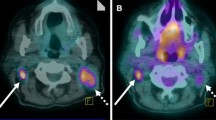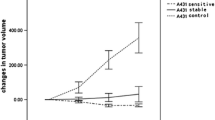Abstract
Because metabolic changes induced by chemotherapy precede the morphological changes, fluorine-18 fluorodeoxyglucose positron emission tomography ([18F]FDG PET) is thought to predict response to therapy earlier and more accurately than other modalities. To be a reliable predictor of response, changes in tumour [18F]FDG uptake should reflect changes in viable cell fraction, but little is known about the contribution of apoptotic and necrotic cancer cells and inflammatory tissue to the [18F]FDG signal. In a tumour mouse model we investigated the relation between chemotherapy-induced changes in various tumoral components and tumour uptake and size. SCID mice were subcutaneously inoculated in the right thigh with 5×106 Daudi cells. When the tumour measured 15–20 mm, Endoxan was given intravenously. At different time points [1–15 days (d1–d15) after the injection of Endoxan], ex vivo autoradiography and histopathology were performed in two mice and [18F]FDG uptake in the tumour and tumour size were correlated with the different cell fractions measured with flow cytometry in five mice. At d1/d3, similar reductions in [18F]FDG uptake and viable tumoral cell fraction were observed and these reductions preceded changes in tumour size. By d8/d10, [18F]FDG uptake had stabilised despite a further reduction in viable tumoral cell fraction. At these time points a major inflammatory response was observed. At d15, an increase in viable tumour cells was again observed and this was accurately predicted by an increase in [18F]FDG uptake, while the tumour volume remained unchanged. In contrast with variations in tumour volume, [18F]FDG is a good marker for chemotherapy response monitoring. However, optimal timing seems crucial since a transient increase in stromal reaction may result in overestimation of the fraction of viable cells.


Similar content being viewed by others
References
Thomas F, Cosset J-M, Cherel P, Renaudy N, Carde P, Pierkarski J. Thoracic CT-scanning follow-up of residual mediastinal masses after treatment of Hodgkin's disease. Radiother Oncol 1988; 11:119–122.
Paul R. Comparison of fluorine-18-2-fluorodeoxyglucose and gallium-67 citrate imaging for the detection of lymphoma. J Nucl Med 1987; 28:288–292.
Vansteenkiste J, Stroobants S, De Leyn P, Dupont P, Verbeken E. Potential use of FDG-PET scan after induction chemotherapy in surgically staged IIIa-N2 non-small-cell lung cancer: a prospective pilot study. Ann Oncol 1998; 9:1193–1198.
Schelling M, Avril N, Näring J, Kuhn W, Romer W, Sattler D, Werner M, Dose J, Janicke F, Greaff H, Schwaiger M. Positron emission tomography using (18F)fluorodeoxyglucose for monitoring primary chemotherapy in breast cancer. J Clin Oncol 2000; 18:1689–1695.
Spaepen K, Stroobants S, Dupont P, van Steenweghen S, Thomas J, Vandenberghe P, Vanuytsel L, Bormans G, Balzarini J, De Wolf-Peeters C, Mortelmans L, Verhoef G. Prognostic value of positron emission tomography with fluorine-18 fluorodeoxyglucose after first line chemotherapy in non Hodgkin's lymphoma: is [18F]FDG-PET a valid alternative to conventional diagnostic methods? J Clin Oncol 2001; 19:414–419.
Weber WA, Ott K, Becker K, Dittler HJ, Helmberger H, Avril NE, Meisetschlager G, Busch R, Siewert HJ, Schwaiger M, Fink U. Prediction of response to preoperative chemotherapy in adenocarcinomas of the esophagogastric junction by metabolic imaging. J Clin Oncol 2001; 19:3058–3065.
Kubota R, Susumu Y, Kubota K, Ishiwata K, Tamahashi N, Ido T. Intratumoral distribution of fluorine-18-fluorodeoxyglucose in vivo: high accumulation in macrophages and granulation tissues studied by microautoradiography. J Nucl Med 1992; 33:1972–1980.
Higashi K, Clavo AC, Wahl RL. In vitro assessment of 2-fluoro-2-deoxy-d-glucose, l-methionine and thymidine as agents to monitor the early response of a human adenocarcinoma cell line to radiotherapy. J Nucl Med 1993; 34:773–779.
Haberkorn U, Morr I, Oberdorfer F, Bellemann ME, Blatter J, Altmann A, Kahn B, van Kaick G. Fluorodeoxyglucose uptake in vitro: aspects of method and effects of treatment with gemcitabine. J Nucl Med 1994; 35:1842–1850.
Reinhardt MJ, Kubota K, Yamade S, Iwata R, Yaegachi H. Assessment of cancer recurrence in residual tumors after fractionated radiotherapy: a comparison of fluorodeoxyglucose,l-methionine and thymidine. J Nucl Med 1997; 38:280–287.
Bosma GS, Custer RP, Bosma MJ. A severe combined immunodeficiency mutation in the mouse. Nature 1983; 301:527–535.
Ghetie MA, Richardson J, Tucker T, Jones D, Uhr J, Vitetta ES. Dissemination or localized growth of a human B-cell tumor (daudi) in SCID mice. Int J Cancer 1990; 45:481–485.
Wahl R, Zasandy K, Helvie M, Hutchins GD, Weber B, Cody R. Metabolic monitoring of breast cancer chemotherapy using positron emission tomography: initial evaluation. J Clin Oncol 1993; 11:2101–2111.
Hoekstra OS, van Lingen A, Ossenkoppele G, Golding R, Teule GJ. Early response monitoring in malignant lymphoma using fluorine-18 fluorodeoxyglucose single-photon emission topography. Eur J Nucl Med 1993; 20:1214–1220.
Jones DN, McCowage CD, Sostman HD, Brizel DM, Layfield L, Charles HC, Dewhirst MW, Prescott DM, Friedman HS, Harrelson JM, Scully SP, Coleman RE. Monitoring of neoadjuvant therapy response of soft-tissue and musculoskeletal sarcoma using fluorine-18-FDG PET. J Nucl Med 1996; 37:1438–1444.
Haberkorn U, Strauss LG, Dimitrakopoulou A, Engenhart R, Oberdorfer F, Ostertag H, Romahn J, van Kaick G. PET studies of fluorodeoxyglucose metabolism in patients with recurrent colorectal tumors receiving radiotherapy. J Nucl Med 1991; 32:1485–1490.
Greiner DL, Hesselton RA, Shultz L. SCID mouse models of human stem cell engraftment. Stem Cells 1998; 16:166–177.
Rozental JM, Levine RL, Mehta MP, Kinsella TJ, Levin AB, Algan O, Mendoza M, Hanson JM, Schrader DA, Nickles RJ. Early changes in tumor metabolism after treatment: the effects of stereotactic radiotherapy. Int J Radiat Onco Biol Phys 1991; 20:1053–1060.
Findlay M, Young H, Cunningham D, Iveson A, Cronin B, Hickish T, Pratt B, Husband J, Flower M, Ott R. Noninvasive monitoring of tumor metabolism using fluorodeoxyglucose and positron emission tomography in colorectal cancer liver metastases: correlation with tumor response to fluorouracil. J Clin Oncol 1996; 14:700–708.
Römer W, Hanauske AR, Ziegler S, et al. Positron emission tomography in non-Hodgkin's lymphoma: assessment of chemotherapy with fluorodeoxyglucose. Blood 1998; 91:4464–4471.
Reed JC. Dysregulation of apoptosis in cancer. J Clin Oncol 1999; 17:2941–2953.
Acknowledgements
We thank Peter Vermaelen and Werner Scheers for their technical support.
This study was supported by grant G.0298.97 from FWO-Vlaanderen (Fonds voor Wetenschappelijk Onderzoek Vlaanderen).
Author information
Authors and Affiliations
Corresponding author
Rights and permissions
About this article
Cite this article
Spaepen, K., Stroobants, S., Dupont, P. et al. [18F]FDG PET monitoring of tumour response to chemotherapy: does [18F]FDG uptake correlate with the viable tumour cell fraction?. Eur J Nucl Med Mol Imaging 30, 682–688 (2003). https://doi.org/10.1007/s00259-003-1120-6
Received:
Accepted:
Published:
Issue Date:
DOI: https://doi.org/10.1007/s00259-003-1120-6




